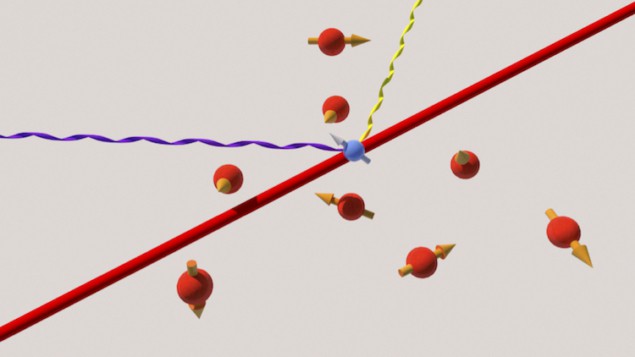
Researchers have developed an efficient way to characterize the effective many-body Hamiltonian of the solid-state spin system associated with a nitrogen-vacancy (NV) centre in diamond. The technique will be important for making and controlling high-fidelity quantum gates in this multi-spin quantum register, they say.
A quantum register is a system made up of many quantum bits (qubits) and it is the quantum equivalent of the classical processor register. Quantum computers work by manipulating qubits within such a register and making and understanding such systems is essential for quantum information processing.
Crosstalk is a problem
Researchers have made quantum registers from many physical systems thus far, including trapped ions, solid-state spins, neutral atoms and superconducting qubits. Whatever their nature, however, they all suffer from the same problem: crosstalk between multiple qubits when an individual qubit is addressed during a measurement. This induces a state error to other qubits and reduces gate fidelity.
One way to overcome this problem is to fully characterize the many-body Hamiltonian of the system, which determines how it evolves and crosstalk interactions. “Once we have this information, we can predict the evolution of any initial states and, what is more, design optimized gate operations to reduce crosstalk errors and achieve high-fidelity gates in a multi-qubit register,” explains Panyu Hou of the Center for Quantum Information at Tsinghua University in Beijing, who is the lead author of this new study. “The Hamiltonian can often be fully described by some essential parameters, which characterize the coupling between the qubits.”
Diamond defects
Hou and colleagues studied the electron spin and the surrounding nuclear spins of a single NV centre in bulk diamond. A NV centre, or defect, is one of the hundreds of colour centres found in natural diamond and it is known to be a promising platform for quantum information processing. The centre involves two adjacent carbon atoms in the diamond lattice being replaced by a nitrogen atom and an empty lattice site (or vacancy).
The electron and nuclear spins in the NV centre each play a different role. Electron spins allow for fast control and high-quality readout and, when coupled to light, allow for entanglement between qubits, even over long distances. This means that they can be used to realize a scalable quantum network. The nuclear spins for their part provide additional qubits that are stable – that is, they have long coherence times – and can thus be used to store and process quantum information.
Constantly-on interactions
For this solid-state spin register, the interactions among all the spin qubits are constantly on, however, explains Hou. This is why there is crosstalk error from the other nuclear spins other than the target one being addressed.
In their work, the researchers characterized the effective many-body coupling Hamiltonian of an NV centre containing one electron spin and ten weakly coupled 13C nuclear spins. They then used the learnt Hamiltonian parameters to optimize the dynamical decoupling sequence and so minimize the effect from the unwanted crosstalk coupling. This adaptive scheme was first put forward by researchers at Delft University in the Netherlands.

10-qubit register breaks new ground in quantum computing
The researchers validated their technique by designing a universal quantum gate set that includes three single-qubit gates for each of the 11 qubits and the entangling two-qubit gate between the electron spin and each of the 10 nuclear spins. “In principle, we can realize any unitary operation on this 11-qubit register by combining the above gate set,” Hou tells Physics World.
“This learning technique could be a useful tool to characterize many-body Hamiltonians with a constantly-on interaction,” he adds. “The 11-qubit quantum register that we made might also be used as a proof-of-principle test of some quantum algorithms.”
The work, which is reported in Chinese Physics Letters, comes hot on the heels of new research from Delft, described in this Physics World article.



